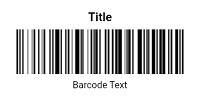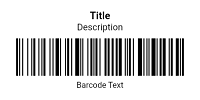Code 128 is a high-density alphanumeric barcode symbology widely used for encoding a range of data types. It is known for its versatility and ability to encode the full ASCII character set, making it suitable for applications requiring diverse data representations.
Developed in the early 1980s by Computer Identics, Code 128 was designed to address the need for a more compact and versatile barcode format. It provides a robust solution for encoding a wide variety of characters and data, which has made it a popular choice across different industries.
Technical Specifications
Code 128 encodes data using a combination of bars and spaces to represent characters. The barcode can include letters (both uppercase and lowercase), numbers, and special characters. The key features of Code 128 include:
Character Sets: Code 128 supports three character sets:
- Code 128 A: Encodes uppercase letters, numbers, and control characters.
- Code 128 B: Encodes uppercase and lowercase letters, numbers, and special characters.
- Code 128 C: Encodes numeric data in a compact format using pairs of digits, which is efficient for encoding long numeric sequences.
Start and Stop Characters: Code 128 includes special start and stop characters that define the beginning and end of the data sequence. This helps scanners identify and process the barcode accurately.
Checksum: Code 128 includes a checksum character that is used for error detection. The checksum is calculated based on the data characters and their positions within the barcode, which enhances data integrity.
Checksum Calculation Process
The checksum in Code 128 is calculated using a weighted sum method:
- Each character in the data string is assigned a value based on its encoding in the Code 128 character set.
- Multiply each character's value by its position (starting with 1 for the first character).
- Sum these weighted values.
- Compute the remainder when this sum is divided by 103.
- The result is the checksum character, which is appended to the end of the data sequence.
This checksum helps verify the accuracy of the data during scanning and processing.
Comparison with Other Barcode Symbologies
Compared to Code 39, Code 128 supports a broader range of characters and offers more compact data encoding. Unlike UPC, which is limited to numeric data and has a fixed length, Code 128 can handle alphanumeric and special characters, providing greater flexibility. Code 128 also includes error detection through its checksum, whereas UPC and Code 39 do not have this feature.
Code 128 offers significant advantages, including its ability to encode a wide range of characters and its compact size compared to other barcodes like Code 39. Its inclusion of a checksum character enhances data accuracy and error detection.
However, Code 128 can be more complex to implement compared to simpler barcodes. Its variable-length nature can lead to varying barcode sizes, and the complexity of encoding and decoding may require more sophisticated scanning equipment.
Real World Applications
Code 128 is used in a variety of applications due to its flexibility and data encoding capabilities:
- Logistics and Shipping: Efficiently encodes product codes, tracking numbers, and other logistical information.
- Retail: Used for labeling products, including complex product codes and price information.
- Manufacturing: Helps in tracking parts and components, managing inventory, and ensuring quality control.
- Healthcare: Applied for patient identification, medication labeling, and medical records management.
Code 128 is a versatile and powerful barcode symbology that provides a high-density solution for encoding a wide range of characters. Its ability to handle complex data, combined with its checksum for error detection, makes it a valuable tool for applications in logistics, retail, manufacturing, and healthcare.
While its complexity and variable length may present challenges, Code 128's flexibility and efficiency have established it as a prominent choice in the world of barcode technology.


